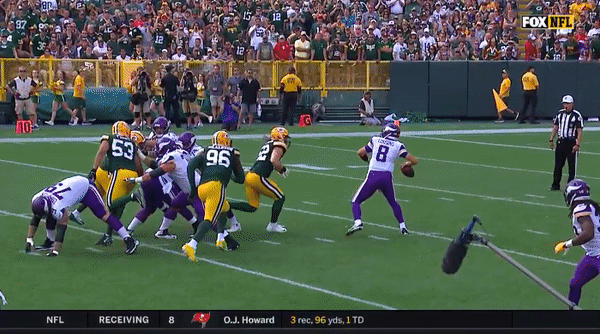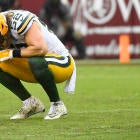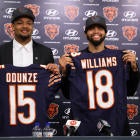The story of the first three weeks of the NFL season -- besides Patrick Mahomes' rapid ascent to the top of the MVP leaderboard -- is roughing the passer. According to ESPN, officials have already flagged roughing the passer 34 times, which marks a sharp increase from 2016 and 2017, when there were 20 and 16 roughing calls through the first three weeks of each respective season.
Fans, players, and coaches aren't the only ones concerned about the enforcement of the rule. So are members of the competition committee.
According to NFL.com's Judy Battista, some members of the competition committee are "uncomfortable" with the roughing the passer penalties we've seen thus far, most notably the Clay Matthews penalty during the Packers' tie with the Vikings in Week 2. Battista reported that there will be a discussion next week, but members are "unsure" if immediate changes will be made. ESPN's Dan Graziano reported something similar, confirming that some members are concerned and that there is a call scheduled. Changes aren't expected to come this year, Graziano added.
Their reports:
I'm told this morning a number of members of the Competition Committee are uncomfortable with the roughing the passer calls, particularly the Clay Mathews one from the Vikings game. Committee call next week, but members are unsure if anything will change this year.
— Judy Battista (@judybattista) September 25, 2018
Why is it possible there will be no change to roughing the passer calls this season? Because there is a feeling it could be difficult for the league to pull back on a safety-related rule.
— Judy Battista (@judybattista) September 25, 2018
When this point of emphasis was made in March, this is clearly not how the Comp. Committee envisioned it. Question may be how Roger Goodell views it and what tweaks can be made that don't diminish the player safety part of it while also eliminating the gratuitous calls.
— Judy Battista (@judybattista) September 25, 2018
Sources: NFL's competition committee is planning a conference call next week to discuss the rash of roughing the passer penalties. There's some concern among the members of the committee that some of the calls are going too far. No changes expected this year, but they're talking.
— Dan Graziano (@DanGrazianoESPN) September 25, 2018
However, according to The Washington Post's Mark Maske, "it is expected that the roughing-the-passer rule will be called differently, with the shift in emphasis becoming clear through officiating videos distributed by the league." In other words, the rule probably won't change, but the enforcement of the rule might.
So, hope for change remains after the first three weeks saw countless controversial roughing penalties. There was the Matthews hit on Kirk Cousins. There was Matthews' hit on Alex Smith on Sunday. And there were more than a few during the Steelers' Monday night win over the Buccaneers.
The root of the problem dates back to the offseason, when the league made the body weight aspect of the rule, which restricts defenders from landing on the quarterback with all of their body weight and driving the quarterback into the ground with excessive force, a point of emphasis. The intent of the rule might've been good (nobody wants Aaron Rodgers breaking his collarbone again), but it's nearly impossible for defenders to avoid landing on a quarterback because of, well, physics.
What was Matthews supposed to do differently here?

Same question for the sack below:
Roughing the passer. Clay Matthews may actually kill a referee at this point pic.twitter.com/ta9zJqrAOO
— Pete Blackburn (@PeteBlackburn) September 23, 2018
Again, the intent of the rule is good. Quarterbacks (and players, in general) should be protected, in part because the moment the Aaron Rodgers and Kirk Cousins of the NFL are replaced by the Brock Osweilers and DeShone Kizers of the NFL is the moment the NFL goes from the most exciting sport on the planet to the most unwatchable. But the league needs to find a way to balance its desire to protect quarterbacks with common sense.
Recognizing and admitting that there is a problem is an important first step. We'll see if changes follow.






















